Footpad dermatitis in poultry: a common issue in commercial and backyard flocks

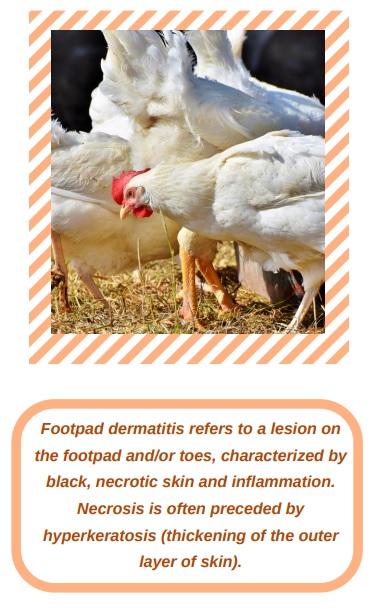 Footpad dermatitis is a common type of contact dermatitis in poultry, which means feet are inflamed and show associated corrosive lesions or ulcers on pads and/or toes. Footpad dermatitis lesions often have a black appearance, because of cell necrosis (cell death). These lesions can be superficial or deep.
Footpad dermatitis is a common type of contact dermatitis in poultry, which means feet are inflamed and show associated corrosive lesions or ulcers on pads and/or toes. Footpad dermatitis lesions often have a black appearance, because of cell necrosis (cell death). These lesions can be superficial or deep.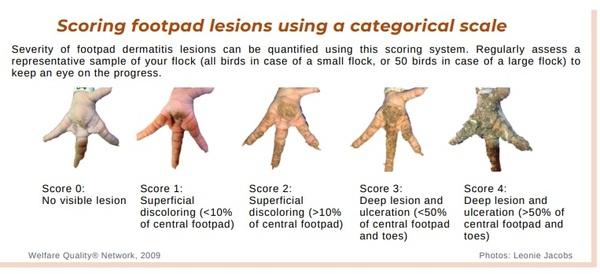
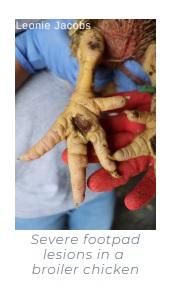 Laying hens: A study examining nearly 300 cage-free laying hen flocks found on average 40% of hens in each flock affected by footpad dermatitis (Niebuhr et al 2009). An experimental study showed footpad dermatitis to be a common issue in both furnished cages as in cage-free birds, with prevalences ranging between 60 and 93% of the birds having a lesion (Weitzenbürger et al 2006).
Laying hens: A study examining nearly 300 cage-free laying hen flocks found on average 40% of hens in each flock affected by footpad dermatitis (Niebuhr et al 2009). An experimental study showed footpad dermatitis to be a common issue in both furnished cages as in cage-free birds, with prevalences ranging between 60 and 93% of the birds having a lesion (Weitzenbürger et al 2006).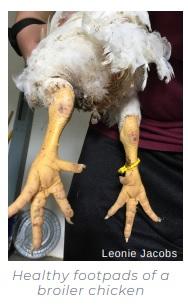 How does footpad dermatitis develop?
How does footpad dermatitis develop?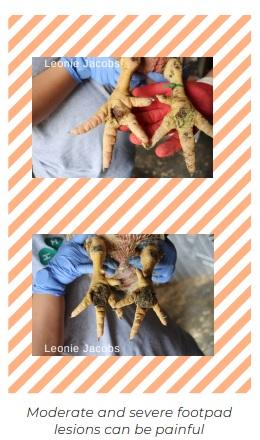 Preventing is better than remedying lesions after they have developed. A key strategy is to manage the litter moisture and associated chemicals. Litter and drinker management play important roles in preventing these issues. Yet, there are some options to heal lesions or reduce the prevalence of footpad dermatitis, which are listed below:
Preventing is better than remedying lesions after they have developed. A key strategy is to manage the litter moisture and associated chemicals. Litter and drinker management play important roles in preventing these issues. Yet, there are some options to heal lesions or reduce the prevalence of footpad dermatitis, which are listed below:- Consult a veterinarian to treat the lesions appropriately.
- Gently clean and wrap the lesion so that the feet are no longer in direct contact with litter or other bedding materials. Replace the bandage frequently.
- Ensure the environment (bedding, litter) is dry, by replacing the litter or topdressing with an absorbent material, such as pine shavings (Freeman et al, 2020).
(1) Opengart, K. et al. 2018. Incidence, severity, and relationship of broiler footpad lesions and gait scores of market-age broilers raised under commercial conditions in the southeastern United States. J. Appl. Poult. Res. 27:424–432 Available at https://doi.org/10.3382/japr/pfy002.
(2) Lund, P.V. et al. Evaluation of the Danish footpad lesion surveillance in conventional and organic broilers: Misclassification of scoring. Poult. Sci. 2017, 96, 2018–2028.
(3) Niebuhr, C. et al. 2009. Foot pad dermatitis in laying hens kept in non-cage systems in Austria. Abstract https://www.cabi.org/Uploads/animal-science/worlds-poultry-scienceassociation/WPSA-italy-2009/6_welfare2009_niebuhr.pdf
(4) Weitzenbürger, D. et al. "Macroscopic and histopathological alterations of foot pads of laying hens kept in small group housing systems and furnished cages." British poultry science 47.5 (2006): 533-543.
(5) Bergmann, S. et al. 2013. Prevalence and severity of foot pad alterations in German turkey poults during the early rearing phase. Poult. Sci. 92, 1171-1176.
(6) Da Costa, M. J. et al. "Footpad dermatitis severity on turkey flocks and correlations with locomotion, litter conditions, and body weight at market age." Journal of Applied Poultry Research 23.2 (2014): 268-279.
(7) Welfare Quality® Network, 2009 http://www.welfarequality.net/media/1019/poultry_protocol.pdf
(8) Freeman, N. et al. 2020. "Remedying Contact Dermatitis in Broiler Chickens with Novel Flooring Treatments." Animals 10.10 (2020): 1761.
Hi:
Aside from material be used for litter that must have enough capacity to absorb water from faeces and waterer, enteritis and feed passage will exacerbate the bacterial growth and ammonia gas in house that induces footpad dermatitis. Hence management of gut health will be effective in preventing footpad dermatitis. Therefore, not only essential oil but also other product like prebiotic can be effective in preventing it.
in my experience, footpad dermatitis is usually seen in cage system of rearing of layer chicks with more birds per cage. This is because of damage caused by cage wires if their gauge of wires is narrow and also sharp nails also cause injury.
In broilers, it depends on the material used, wet litter and more ammonia in sheds.

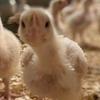















.jpg&w=3840&q=75)